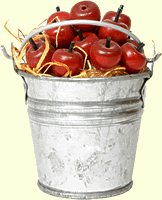|
Traditional
Means of Storing Garden Produce
Storing
vegetables and fruits.
Most
people today, comfortable in the knowledge that the supermarket
is just five minutes away, and all food can be safely
stored in refrigerator or pantry shelf, never give a thought
to the perils of storing seasonal produce. In the pre-industrial
world most country people stored and preserved their kitchen
garden produce for use out of season. Preserving is not
discussed here (that article will come at a later date)
but below we discuss some of the traditional means of
storing the garden produce.
 Clamping Clamping
Clamping
is an age-old means of storing root crops - potatoes are
particularly suited to this. In the autumn a patch of
ground was dug out, perhaps a metre (or a yard) square,
and about 50 centimeters of dry straw laid on the ground.
The potatoes, which had been left on the surface of the
ground to dry for a few days so that their skin might
'harden' (or dry out a little, it didn't do the crop any
good if it sweated once placed into the clamp), were then
piled in a pyramidical shape on the straw to perhaps a
metre in height (this shape enabled water runoff). The
gardener then covered them thickly with straw, then shovelled
earth over the entire lot, packing it in tightly to exclude
any light. There was always a little bit of straw left
poking out at the very top of this rough pyramid, plus
some more at its foot to provide aeration into the potato
stack, but not enough room for the rats and mice to get
in. it was better, in the small household, to build smaller
clamps rather than large ones, as once they were opened
the potatoes needed to be used.
In
larger houses the potatoes could be clamped in long rectangular
ridges rather than pyramids, the ridge being sharp enough
to provide the runoff needed for rain. Potatoes would
also be sorted in the ridge according to how well they
kept, those that lasted the longest being at the far end
of the ridge.
Storage in the ground
Many
root crops could be safely left in the ground. In areas
where there was not too much winter frost, root vegetables
like parsnips and sometimes carrots could be left in the
ground until needed. The tops might be cut off to prevent
them growing.
'Heeling in'
Some
vegetables might be 'heeled in', leeks can be stored well
this way until they are required. The leeks are dug up
and have their tops cut off. Then they are placed back
in the soil, tightly bunches, their roots loosely covered
with earth and then firmed in with the heel. They keep
perfectly well this way and do not continue to grow.
Stringing
and Hanging
Garlic
and onions would be dug from the ground when fine weather
was expected, then left in rows on the ground to dry.
They could then be string together using their leaves
and hung in a cool dry place until needed.
Gourds,
pumpkins and the like would also be hung, strung in nets
to keep their skins unbruised, and out of the reach of
rats and mice.
Storing
in sand
Some
root vegetables, like beet, carrots, turnips, parsnips,
scorzonera and salsify, could also be stored packed carefully
in dry sand in barrels as well as in earth-covered clamps.
The
Root Cellar
Of
course, there was always the root cellar where produce
could be stored using some of the means discussed above.
the cellar bhad to be kept cool and dark, and not too
humid. It generally had various bays or storage bins.
|
 Storing
Fruit Storing
Fruit
Fruits
such as grapes, cherries, currants and gooseberries could
be stored 'on the branch' in a fruit or grape room. The
fruit would be picked with a length of stem or branch
attached, and this then would be placed into special bottles
on shelves in the fruit room. Each bunch had its own bottle
(which can be described only as being rather like flattened
hospital urinals, or bottles, in shape). The water in
these bottles was regularly topped up, and fruit could
last an entire year this way, enabling the big house to
enjoy grapes or other branched fruit year round.
Grapes
could also be left on the vine, or they could be hung
in smoky rooms and preserved that way.
Other
fruit, such as apples and pears, would be stored on boards
in darkened, cool storage rooms. Fruit rooms, as they
were known, were particularly popular in the eighteenth
and nineteenth centuries. They were kept cool and dark
and, as much as possible, at a constant humidity. The
fruit was cleaned carefully before it was placed on an
equally clean shelf, usually composed of wooden slats,
and no one piece fruit was allowed to touch another (unless
it was cooking apples or pears, rather than table fruit,
in which case they might be stored in wicker baskets under
the lowest shelves). In ancient times fruit was often
wrapped in moss, or straw, or some other soft cushioning
material, but this tended to encourage mould, and so by
the eighteenth century careful storage on wooden airy
shelves predominated.
|
Please
also visit Old London Maps
on the web as many of the maps
and views available there have plans and depictions of gardens
from
the medieval period through to the late nineteenth century.
Copyright
© Sara Douglass Enterprises Pty Ltd 2006
No material may be reproduced without permission
unless
specifically stated otherwise
|



 Clamping
Clamping Storing
Fruit
Storing
Fruit